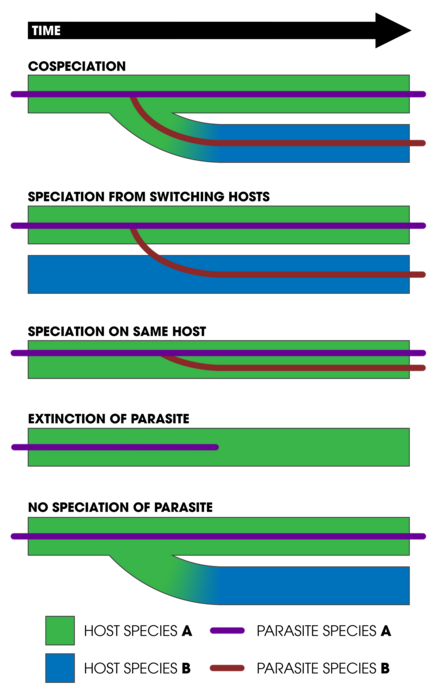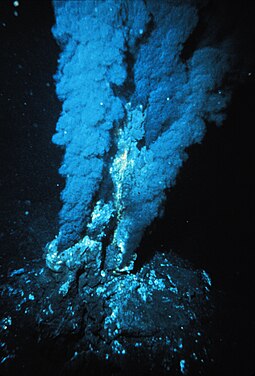
Parasitism is a close relationship between species, where one organism, the parasite, lives on or inside another organism, the host, causing it some harm, and is adapted structurally to this way of life. The entomologist E. O. Wilson has characterised parasites as "predators that eat prey in units of less than one". Parasites include single-celled protozoans such as the agents of malaria, sleeping sickness, and amoebic dysentery; animals such as hookworms, lice, mosquitoes, and vampire bats; fungi such as honey fungus and the agents of ringworm; and plants such as mistletoe, dodder, and the broomrapes. There are six major parasitic strategies of exploitation of animal hosts, namely parasitic castration, directly transmitted parasitism, trophically transmitted parasitism, vector-transmitted parasitism, parasitoidism, and micropredation.

Louse is the common name for members of the clade Phthiraptera, which contains nearly 5,000 species of wingless parasitic insect. Phthiraptera has variously been recognized as an order, infraorder, or a parvorder, as a result of developments in phylogenetic research.

In biology, coevolution occurs when two or more species reciprocally affect each other's evolution through the process of natural selection. The term sometimes is used for two traits in the same species affecting each other's evolution, as well as gene-culture coevolution.

Coextinction and cothreatened refer to the phenomena of the loss or decline of a host species resulting in the loss or endangerment of an other species that depends on it, potentially leading to cascading effects across trophic levels. The term originated by the authors Stork and Lyal (1993) and was originally used to explain the extinction of parasitic insects following the loss of their specific hosts. The term is now used to describe the loss of any interacting species, including competition with their counterpart, and specialist herbivores with their food source. Coextinction is especially common when a keystone species goes extinct.

In biology, two related species or populations are considered sympatric when they exist in the same geographic area and thus frequently encounter one another. An initially interbreeding population that splits into two or more distinct species sharing a common range exemplifies sympatric speciation. Such speciation may be a product of reproductive isolation – which prevents hybrid offspring from being viable or able to reproduce, thereby reducing gene flow – that results in genetic divergence. Sympatric speciation may, but need not, arise through secondary contact, which refers to speciation or divergence in allopatry followed by range expansions leading to an area of sympatry. Sympatric species or taxa in secondary contact may or may not interbreed.

The Prodoxidae are a family of moths, generally small in size and nondescript in appearance. They include species of moderate pest status, such as the currant shoot borer, and others of considerable ecological and evolutionary interest, such as various species of "yucca moths".

Roderic Dugald Morton Page is a New Zealand-born evolutionary biologist at the University of Glasgow, Scotland, and the author of several books. As of 2015 he is professor at the University of Glasgow and was editor of the journal Systematic Biology until the end of 2007. His main interests are in phylogenetics, evolutionary biology and bioinformatics.

The Red Queen hypothesis is a hypothesis in evolutionary biology which proposes that species must constantly adapt, evolve, and proliferate in order to survive while pitted against ever-evolving opposing species. The hypothesis was intended to explain the constant (age-independent) extinction probability as observed in the paleontological record caused by co-evolution between competing species; however, it has also been suggested that the Red Queen hypothesis explains the advantage of sexual reproduction at the level of individuals, and the positive correlation between speciation and extinction rates in most higher taxa.

Avian malaria is a parasitic disease of birds, caused by parasite species belonging to the genera Plasmodium and Hemoproteus. The disease is transmitted by a dipteran vector including mosquitoes in the case of Plasmodium parasites and biting midges for Hemoproteus. The range of symptoms and effects of the parasite on its bird hosts is very wide, from asymptomatic cases to drastic population declines due to the disease, as is the case of the Hawaiian honeycreepers. The diversity of parasites is large, as it is estimated that there are approximately as many parasites as there are species of hosts. Co-speciation and host switching events have contributed to the broad range of hosts that these parasites can infect, causing avian malaria to be a widespread global disease, found everywhere except Antarctica.

Plant evolution is the subset of evolutionary phenomena that concern plants. Evolutionary phenomena are characteristics of populations that are described by averages, medians, distributions, and other statistical methods. This distinguishes plant evolution from plant development, a branch of developmental biology which concerns the changes that individuals go through in their lives. The study of plant evolution attempts to explain how the present diversity of plants arose over geologic time. It includes the study of genetic change and the consequent variation that often results in speciation, one of the most important types of radiation into taxonomic groups called clades. A description of radiation is called a phylogeny and is often represented by type of diagram called a phylogenetic tree.

Host–parasite coevolution is a special case of coevolution, where a host and a parasite continually adapt to each other. This can create an evolutionary arms race between them. A more benign possibility is of an evolutionary trade-off between transmission and virulence in the parasite, as if it kills its host too quickly, the parasite will not be able to reproduce either. Another theory, the Red Queen hypothesis, proposes that since both host and parasite have to keep on evolving to keep up with each other, and since sexual reproduction continually creates new combinations of genes, parasitism favours sexual reproduction in the host.

Ecological fitting is "the process whereby organisms colonize and persist in novel environments, use novel resources or form novel associations with other species as a result of the suites of traits that they carry at the time they encounter the novel condition". It can be understood as a situation in which a species' interactions with its biotic and abiotic environment seem to indicate a history of coevolution, when in actuality the relevant traits evolved in response to a different set of biotic and abiotic conditions.
Incomplete lineage sorting, also termed deep coalescence, retention of ancestral polymorphism, or trans-species polymorphism, describes a phenomenon in population genetics when ancestral gene copies fail to coalesce into a common ancestral copy until deeper than previous speciation events. In other words, the tree produced by a single gene differs from the population or species level tree, producing a discordant tree. Effects caused by lineage sorting of genetic polymorphisms that were retained across successive nodes in the species tree have been called hemiplasy. Whatever the mechanism, the result is that a generated species level tree may differ depending on the selected genes used for assessment. This is in contrast to complete lineage sorting, where the tree produced by the gene is the same as the population or species level tree. Both are common results in phylogenetic analysis, although it depends on the gene, organism, and sampling technique.

Eichler's rule is one of several coevolutionary rules which states that parasites tend to be highly specific to their hosts, and thus it seems reasonable to expect a positive co-variation between the taxonomic richness of hosts and that of their parasites.

Escape and radiate coevolution is a hypothesis proposing that a coevolutionary 'arms-race' between primary producers and their consumers contributes to the diversification of species by accelerating speciation rates. The hypothesized process involves the evolution of novel defenses in the host, allowing it to "escape" and then "radiate" into differing species.

Ecological speciation is a form of speciation arising from reproductive isolation that occurs due to an ecological factor that reduces or eliminates gene flow between two populations of a species. Ecological factors can include changes in the environmental conditions in which a species experiences, such as behavioral changes involving predation, predator avoidance, pollinator attraction, and foraging; as well as changes in mate choice due to sexual selection or communication systems. Ecologically-driven reproductive isolation under divergent natural selection leads to the formation of new species. This has been documented in many cases in nature and has been a major focus of research on speciation for the past few decades.

A biological rule or biological law is a generalized law, principle, or rule of thumb formulated to describe patterns observed in living organisms. Biological rules and laws are often developed as succinct, broadly applicable ways to explain complex phenomena or salient observations about the ecology and biogeographical distributions of plant and animal species around the world, though they have been proposed for or extended to all types of organisms. Many of these regularities of ecology and biogeography are named after the biologists who first described them.

The genus Ficus is composed of 800 species of vines, shrubs, and trees, defined by their syconiums, the fruit-like vessels that either hold female flowers or pollen on the inside. In addition to being cultivated by humans for thousands of years, Ficus is also known for their reproductive mutualism with the fig wasp.
This glossary of evolutionary biology is a list of definitions of terms and concepts used in the study of evolutionary biology, population biology, speciation, and phylogenetics, as well as sub-disciplines and related fields. For additional terms from related glossaries, see Glossary of genetics, Glossary of ecology, and Glossary of biology.

Harrison's rule is an observation in evolutionary biology by Launcelot Harrison which states that in comparisons across closely related species, host and parasite body sizes tend to covary positively.



















